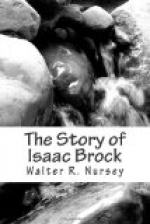Side-wheel ferries, driven by horse-power, plied between the river’s mouth and the Queenston landing. The paddle-wheels of these were open double-spoke affairs, without any circular rim. A stage-coach also ran between Queenston and Fort Erie, the first in Upper Canada. For one dollar the passenger could travel twenty-five miles.
At Fort Erie, at the head of the Niagara River, Brock embarked in mid-August in a government schooner. He wished to familiarize himself with the upper water-ways. He made the long trip from Quebec to York, and thence to Niagara, Amherstburg, Detroit, Sandwich and return overland to Fort George, within two months—record time. Dobson accompanied his master. Brock was silent as to his impressions, but admitted he was convinced that the water route for a military expedition was the only practical one, and that Mackinaw, held by the United States, was the portal and key to the western frontier in case of invasion. He crossed overland through the “bad woods” and open plains to the Point of Pines, where batteaux and canoes awaited him. From thence he proceeded along the north shore of Lake Erie until abreast of the Miami, a confluent of the Ohio River, on the south shore, then turned northward up the Detroit River, twenty-five miles farther, reaching Amherstburg—called Malden by the Americans—250 miles from Fort Erie. Here, after consulting with Colonel St. George, he inspected the battery at Sandwich, and with little ceremony visited Detroit—the old military post of Pontchartrain—on the opposite side of the river, later notorious as an emporium for “rum, tomahawks and gunpowder.” From Amherstburg, a small village with an uncompleted fort and shipyard, he sent messengers to the remote post of St. Joseph, an island, fifty-five miles from Mackinaw, below Sault Ste. Marie, and started homewards overland.
In returning, he skirted the great tributary marshes, alive with water-fowl of every description, whose gabble and flapping wings could be heard at a long distance. He camped in the vast hardwood forests that covered the western point of the peninsula that extends west from Lake Ontario to the river connecting Lake Huron with Lake Erie. He shot big bustards and wild turkeys in the bush, where wolves and deer were as thick as rabbits in a warren, and tramped the uplands, teeming with quail and prairie chicken. Continuing by Delaware and the Government road at Oxford on the Thames, and by the “Long Woods” over the Burford Plains to Brant’s Ford, he reached the Grand River, and then by Ancaster and the head of the lake to Burlington, when he followed the Lake Ontario southern shore road to Niagara.




